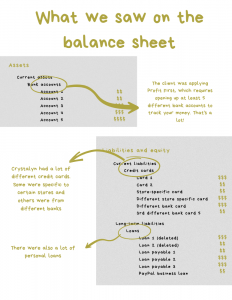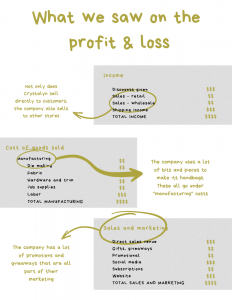Who we worked with
Crystalynn Kae started crafting handbags over 20 years ago when she realized a need for sustainable and unique options in the fashion world. In 2001, Crystalyn Kae opened her shop with a collection of handbags created from a warehouse stash of vintage plaid pants. Her designs still focus on the use of upcycled and repurposed material and can be found on her website, in her boutique in Seattle, and at boutiques across the USA.
Our initial review
Crystalyn came to us for help reorganizing her books for the past two years. She wanted to focus her time designing her accessories, so she integrated a lot of software with the hope that it would save her some time on bookkeeping. As we investigated her books, we noticed a number of issues pop up that were most likely caused by these integrations.
Here’s what we noticed when we took a closer look:
- We saw a lot of bank and card accounts
- A few credit cards were synched with QuickBooks, but a majority of them were not
- We saw a lot more transactions than normal
- QuickBooks was integrated with the client’s point of sale system and payment processor
- Multiple software and third party systems were used to integrate the same data
What we did
In order to clean up the books and make sense of the amount of transactions, we started by looking at the integrations.
Step one: ⚙️ Understand the software. We researched the integration to understand how it works, what numbers it records and where they go, and how it captures things like sales, inventory data, etc.
Step two: 📊 Review the data and reports that came from the integration software. We analyzed the numbers to make sure they were correctly labeled so we can compare the software’s data to the same data in QuickBooks. We found multiple issues where a number was not correctly identified and we had to figure out what that number actually referred to.
Step three: 🔬 Compare the statements with QuickBooks. We compared the numbers and investigated anything that didn’t quite add up. In this step we noticed that Crystalyn’s two integrations were reporting duplicate numbers. That means twice the transactions AND twice the income was being reported. We also noticed another integration that we didn’t know about before: the inventory software.
Step four: 🧐 Investigate the new integration. We completed steps one-three for the inventory management software integration. Through our thorough research, we found out that the inventory management system’s integrations were bought out and managed by another company halfway through the year. Instead of going through each transaction to look for variations (which would have taken a lot more time and cost a lot more money), we reversed the integration and recorded the information manually. A lot of things could have happened, from more duplicate transactions to the integration breaking or changing halfway through. This saved us some time.
Step five: 🔄 Repeat steps one-four for all integrations we found. By the end of our research into the books and the software integrations, we ended up finding five total integrations that needed to be analyzed and fixed.
Step six: 🧹 Clean the books. We created journal entries and notes about how the integration works and then organized the books in a way that would make sense to Crystalyn moving forward.
Step seven: ⏩ Create a projection that shows what Crystalyn can expect in the next six months to a year. This projection was created specifically for her to ensure that it’s easy to use and understand and can provide valuable insight into how Crystalyn Kae is expected to do in the future.
Step eight: 👯 Consult with the client. Here’s where we really get our client onto the same page. We shared our findings, provided advisory, shared our projection, and helped Crystalyn get her business refreshed and revitalized for the future.
🔹 Pro-tip: Before you integrate a new software into your accounting system, you need to really understand how it works. Ask yourself the 5 questions of integration: What software are you using, who is going to be keeping an eye on the integration to watch for changes, why are you integrating, how does it work, and what are you going to do if it breaks? Keep in mind that automation is great, but that doesn’t eliminate the need for a human to go in and review the work. Check in with an accountant to see if this integration will really save you time and money, or just cost more in the long run.


Share this article




